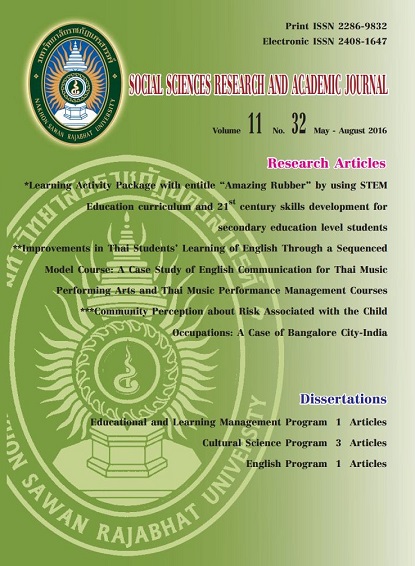A Development Model of Teaching for Mathematical Problem Solving of Prathomsuksa 6 Students
Main Article Content
Abstract
The objectives of this study were to: 1) develop and evaluate the quality of a teaching model
for mathematical problem solving of Prathomsuksa 6 students and 2) study the findings of employment of a teaching model for mathematical problem solving of Prathomsuksa 6. The research method employed Research and Development (R&D). The research procedure comprised 2 steps: step1, the development of a teaching model for mathematical problem solving of Prathomsuksa 6 students. Step 2, the implementation and the findings of a teaching model for mathematical problem solving of Prathomsuksa 6 students. The subjects were 193 Prathomsuksa 6 students using cluster sampling. The research instrument was a learning model using 2×2 factorial research design. If there was a different statistically significant, it would use a Scheffe Analysis.
The results of research were as follows:
1) A development model of teaching for mathematical problem solving of Prathomsuksa 6
students comprised 5 components: conceptual model, objectives, learning outcome expectation, learning and teaching procedures and evaluation. Learning and teaching procedures comprised 5 steps: 1) Understanding the problem, 2) Analysis problem solving and synthesis, 3) Taking action, 4) Review of problem solving process and 5) Application life wide learning.
2) The findings of employment of a teaching model for mathematical problem solving of Prathomsuksa 6 students. Students were taught with 2 models: a teaching model for mathematical problem solving and a normal teaching model. The students who were different learning abilities, had different mathematical solving problem abilities and the different scores of mathematical post-test. The findings found that there was a significant difference between 2 groups at the .05 level. The students were taught with the teaching model for mathematical problem solving in gifted classes and the students who were taught with a teaching model for mathematical problem solving in normal classes, Their mathematical problem solving abilities and learning achievement of the post-test mean scores were significantly higher than the pre-test mean scores at the significance level of .05.

